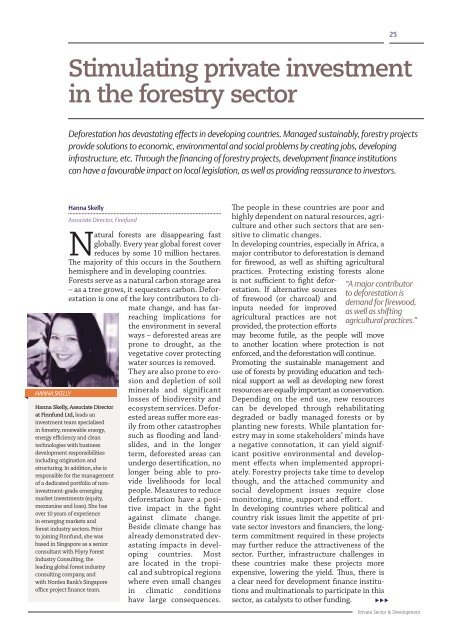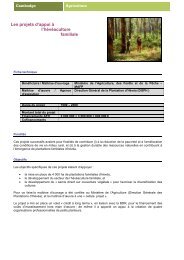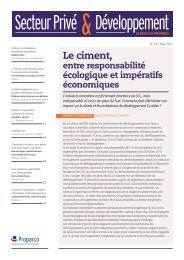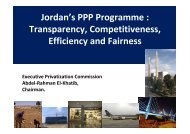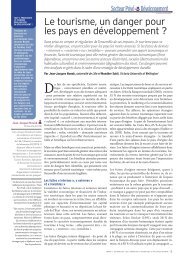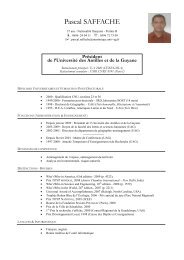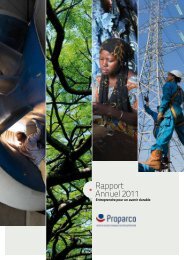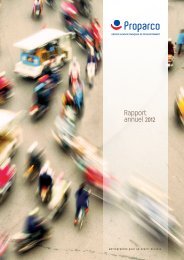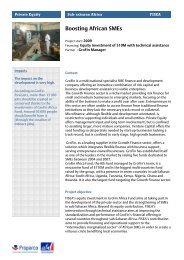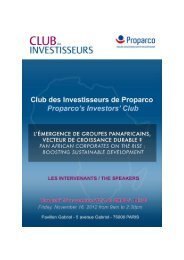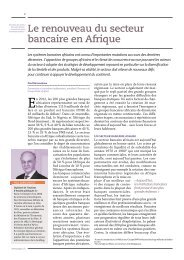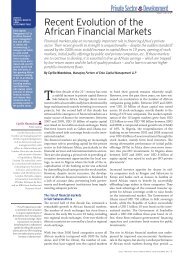Stimulating private investment in the forestry sector - Proparco
Stimulating private investment in the forestry sector - Proparco
Stimulating private investment in the forestry sector - Proparco
Create successful ePaper yourself
Turn your PDF publications into a flip-book with our unique Google optimized e-Paper software.
<strong>Stimulat<strong>in</strong>g</strong> <strong>private</strong> <strong><strong>in</strong>vestment</strong><strong>in</strong> <strong>the</strong> <strong>forestry</strong> <strong>sector</strong>25Deforestation has devastat<strong>in</strong>g effects <strong>in</strong> develop<strong>in</strong>g countries. Managed susta<strong>in</strong>ably, <strong>forestry</strong> projectsprovide solutions to economic, environmental and social problems by creat<strong>in</strong>g jobs, develop<strong>in</strong>g<strong>in</strong>frastructure, etc. Through <strong>the</strong> f<strong>in</strong>anc<strong>in</strong>g of <strong>forestry</strong> projects, development f<strong>in</strong>ance <strong>in</strong>stitutionscan have a favourable impact on local legislation, as well as provid<strong>in</strong>g reassurance to <strong>in</strong>vestors.HANNA SKELLYHanna SkellyAssociate Director, F<strong>in</strong>nfundNatural forests are disappear<strong>in</strong>g fastglobally. Every year global forest coverreduces by some 10 million hectares.The majority of this occurs <strong>in</strong> <strong>the</strong> Sou<strong>the</strong>rnhemisphere and <strong>in</strong> develop<strong>in</strong>g countries.Forests serve as a natural carbon storage area– as a tree grows, it sequesters carbon. Deforestationis one of <strong>the</strong> key contributors to climatechange, and has farreach<strong>in</strong>gimplications for<strong>the</strong> environment <strong>in</strong> severalways – deforested areas areprone to drought, as <strong>the</strong>vegetative cover protect<strong>in</strong>gwater sources is removed.They are also prone to erosionand depletion of soilHanna Skelly, Associate Directorat F<strong>in</strong>nfund Ltd, leads an<strong><strong>in</strong>vestment</strong> team specialised<strong>in</strong> <strong>forestry</strong>, renewable energy,energy efficiency and cleantechnologies with bus<strong>in</strong>essdevelopment responsibilities<strong>in</strong>clud<strong>in</strong>g orig<strong>in</strong>ation andstructur<strong>in</strong>g. In addition, she isresponsible for <strong>the</strong> managementof a dedicated portfolio of non<strong><strong>in</strong>vestment</strong>-gradeemerg<strong>in</strong>gmarket <strong><strong>in</strong>vestment</strong>s (equity,mezzan<strong>in</strong>e and loan). She hasover 10 years of experience<strong>in</strong> emerg<strong>in</strong>g markets andforest <strong>in</strong>dustry <strong>sector</strong>s. Priorto jo<strong>in</strong><strong>in</strong>g F<strong>in</strong>nfund, she wasbased <strong>in</strong> S<strong>in</strong>gapore as a seniorconsultant with Pöyry ForestIndustry Consult<strong>in</strong>g, <strong>the</strong>lead<strong>in</strong>g global forest <strong>in</strong>dustryconsult<strong>in</strong>g company, andwith Nordea Bank’s S<strong>in</strong>gaporeoffice project f<strong>in</strong>ance team.m<strong>in</strong>erals and significantlosses of biodiversity andecosystem services. Deforestedareas suffer more easilyfrom o<strong>the</strong>r catastrophessuch as flood<strong>in</strong>g and landslides,and <strong>in</strong> <strong>the</strong> longerterm, deforested areas canundergo desertification, nolonger be<strong>in</strong>g able to providelivelihoods for localpeople. Measures to reducedeforestation have a positiveimpact <strong>in</strong> <strong>the</strong> fightaga<strong>in</strong>st climate change.Beside climate change hasalready demonstrated devastat<strong>in</strong>gimpacts <strong>in</strong> develop<strong>in</strong>gcountries. Mostare located <strong>in</strong> <strong>the</strong> tropicaland subtropical regionswhere even small changes<strong>in</strong> climatic conditionshave large consequences.The people <strong>in</strong> <strong>the</strong>se countries are poor andhighly dependent on natural resources, agricultureand o<strong>the</strong>r such <strong>sector</strong>s that are sensitiveto climatic changes.In develop<strong>in</strong>g countries, especially <strong>in</strong> Africa, amajor contributor to deforestation is demandfor firewood, as well as shift<strong>in</strong>g agriculturalpractices. Protect<strong>in</strong>g exist<strong>in</strong>g forests aloneis not sufficient to fight deforestation.If alternative sourcesof firewood (or charcoal) and<strong>in</strong>puts needed for improvedagricultural practices are notprovided, <strong>the</strong> protection effortsmay become futile, as <strong>the</strong> people will moveto ano<strong>the</strong>r location where protection is notenforced, and <strong>the</strong> deforestation will cont<strong>in</strong>ue.Promot<strong>in</strong>g <strong>the</strong> susta<strong>in</strong>able management anduse of forests by provid<strong>in</strong>g education and technicalsupport as well as develop<strong>in</strong>g new forestresources are equally important as conservation.Depend<strong>in</strong>g on <strong>the</strong> end use, new resourcescan be developed through rehabilitat<strong>in</strong>gdegraded or badly managed forests or byplant<strong>in</strong>g new forests. While plantation <strong>forestry</strong>may <strong>in</strong> some stakeholders’ m<strong>in</strong>ds havea negative connotation, it can yield significantpositive environmental and developmenteffects when implemented appropriately.Forestry projects take time to developthough, and <strong>the</strong> attached community andsocial development issues require closemonitor<strong>in</strong>g, time, support and effort.In develop<strong>in</strong>g countries where political andcountry risk issues limit <strong>the</strong> appetite of <strong>private</strong><strong>sector</strong> <strong>in</strong>vestors and f<strong>in</strong>anciers, <strong>the</strong> longtermcommitment required <strong>in</strong> <strong>the</strong>se projectsmay fur<strong>the</strong>r reduce <strong>the</strong> attractiveness of <strong>the</strong><strong>sector</strong>. Fur<strong>the</strong>r, <strong>in</strong>frastructure challenges <strong>in</strong><strong>the</strong>se countries make <strong>the</strong>se projects moreexpensive, lower<strong>in</strong>g <strong>the</strong> yield. Thus, <strong>the</strong>re isa clear need for development f<strong>in</strong>ance <strong>in</strong>stitutionsand mult<strong>in</strong>ationals to participate <strong>in</strong> this<strong>sector</strong>, as catalysts to o<strong>the</strong>r fund<strong>in</strong>g.“A major contributorto deforestation isdemand for firewood,as well as shift<strong>in</strong>gagricultural practices.”Private Sector & Development
26<strong>Stimulat<strong>in</strong>g</strong> <strong>private</strong> <strong><strong>in</strong>vestment</strong> <strong>in</strong> <strong>the</strong> <strong>forestry</strong> <strong>sector</strong>Utilis<strong>in</strong>g,develop<strong>in</strong>g andpreserv<strong>in</strong>gforests: f<strong>in</strong>d<strong>in</strong>g<strong>the</strong> balance.Forestry is one of F<strong>in</strong>land’s developmentpolicy <strong>the</strong>mes, and regard<strong>in</strong>g <strong>the</strong> susta<strong>in</strong>ableuse and protection of forests, F<strong>in</strong>landand <strong>the</strong> develop<strong>in</strong>g countries share <strong>the</strong>same goals. Forestry offers economic opportunitiesand social and environmental benefits.By provid<strong>in</strong>g a framework for susta<strong>in</strong>able<strong>forestry</strong>, equitable economic growth iscreated, poverty is reduced, and threats to<strong>the</strong> environment are prevented. F<strong>in</strong>nfundis one of <strong>the</strong> <strong>in</strong>struments for implement<strong>in</strong>gF<strong>in</strong>land’s development policy, and ithas established a dedicated team to reviewopportunities <strong>in</strong> this area.Forestry and development impactsDevelopment f<strong>in</strong>ance <strong>in</strong>stitutions such asF<strong>in</strong>nfund require <strong>the</strong>ir <strong><strong>in</strong>vestment</strong>s to beboth profitable and to generate measurabledevelopment impacts <strong>in</strong> <strong>the</strong> project country.In addition to effectively mitigat<strong>in</strong>g climatechange, <strong>forestry</strong> projects also providea wide range of <strong>the</strong>se development impacts.Forestry projects tend to be located <strong>in</strong> ruralareas where formal employment opportunitiesare few, <strong>the</strong>y are labour <strong>in</strong>tensive– a large project easily employs thousandsof people – and many tasks aremanual. Employment requirements rangefrom <strong>the</strong> performance of simple tasksto more demand<strong>in</strong>g positions. Womenare equally easily employable. This largeemployee base supports <strong>the</strong> developmentof additional economic activities, provid<strong>in</strong>glivelihoods for even more people.This potentially improves resilience andsupports adaptation to <strong>the</strong> effects of climatechange.Forestry projects require <strong>in</strong>frastructure,both <strong>in</strong> <strong>the</strong>ir immediate area and from <strong>the</strong>project site to markets, and most projects<strong>in</strong>vest heavily <strong>in</strong> develop<strong>in</strong>g and ma<strong>in</strong>ta<strong>in</strong><strong>in</strong>git. As <strong>the</strong> project sites tend to be verylarge, <strong>the</strong> whole region generally benefitsfrom this.While <strong>the</strong> land use and tenure regulationsof <strong>the</strong> relevant country determ<strong>in</strong>e whe<strong>the</strong>r<strong>forestry</strong> projects will be based on land ownershipor o<strong>the</strong>r types of tenure, <strong>the</strong>y typicallymake some form of payment ei<strong>the</strong>r to<strong>the</strong> government or to local agencies or communitiesfor <strong>the</strong> use of <strong>the</strong> land and wood.The projects also contribute to <strong>the</strong> localeconomy through direct and <strong>in</strong>direct taxesand <strong>in</strong> o<strong>the</strong>r ways. Wood products oftenhave significant export value, have welldevelopedglobal markets, and can providesignificant export revenues to <strong>the</strong> country.Well-managed, legally operat<strong>in</strong>g plantation<strong>forestry</strong> projects help battle illegal logg<strong>in</strong>g.They contribute to <strong>the</strong> development of officialand legal wood product markets, and meet<strong>the</strong> demand that illegal logg<strong>in</strong>g attempts tosatisfy. They help officials and governmentsas well as local people to understand <strong>the</strong> benefitsof legally operat<strong>in</strong>g projects, and thusmake <strong>the</strong> operations of illegal loggers moredifficult and less profitable.Properly implemented plantation <strong>forestry</strong>projects set an example of good governanceand may help host countries to develop susta<strong>in</strong>able<strong>forestry</strong> policies.In F<strong>in</strong>nfund’s experience, <strong>forestry</strong> projectshave provided <strong>the</strong> significant developmentimpacts expected of <strong>the</strong>m. As an example,F<strong>in</strong>nfund has been an <strong>in</strong>vestor <strong>in</strong> a teakproject <strong>in</strong> Tanzania for more than ten years.This company supports <strong>the</strong> people with<strong>in</strong> itsarea <strong>in</strong> many ways. For example,it has f<strong>in</strong>anced schoolsand health care, and now providesjobs for several hundredpeople <strong>in</strong> one of <strong>the</strong> poorestareas <strong>in</strong> Tanzania. When harvest<strong>in</strong>gand process<strong>in</strong>g get <strong>in</strong>tofull sw<strong>in</strong>g, several thousandjobs will be generated directlyand <strong>in</strong>directly. When <strong>the</strong> wood trade andprocess<strong>in</strong>g are established, teak looks setto become an important crop plant for <strong>the</strong>area and a major export product for Tanzania,provid<strong>in</strong>g over 130 million dollars ofexport revenues over a ten-year period.Unfortunately, where a bus<strong>in</strong>ess fails, <strong>the</strong>developmental impacts are largely lost aswell. Dur<strong>in</strong>g its history of <strong>forestry</strong> projects,F<strong>in</strong>nfund has experienced one such failedproject. In that case, <strong>the</strong> failure was ma<strong>in</strong>lycaused by changes <strong>in</strong> <strong>the</strong> political and operat<strong>in</strong>genvironment that made it impossibleto have staff on <strong>the</strong> ground and to cont<strong>in</strong>ueto develop <strong>the</strong> project. In some o<strong>the</strong>rprojects where <strong>the</strong> bus<strong>in</strong>ess has developedslower than expected, significant valuesare still captured <strong>in</strong> <strong>the</strong> grow<strong>in</strong>g biologicalassets, and while <strong>the</strong> overall returns of<strong>the</strong> project will be negatively impacted, <strong>the</strong>developmental impacts are still significant.“There is a clear needfor developmentf<strong>in</strong>ance <strong>in</strong>stitutionsand mult<strong>in</strong>ationalsto participate <strong>in</strong> this<strong>sector</strong>, as catalyststo o<strong>the</strong>r fund<strong>in</strong>g.”F<strong>in</strong>nfund’s <strong><strong>in</strong>vestment</strong> criteria<strong>in</strong> <strong>forestry</strong> and <strong>forestry</strong>-related projectsDue to <strong>the</strong> significance of <strong>the</strong> <strong>forestry</strong> <strong>sector</strong> forF<strong>in</strong>land's economy 1 , its technical know-how 2 and<strong>the</strong> expected development and environmentalbenefits delivered by <strong>the</strong> <strong>sector</strong>, it follows thatthis is also one of <strong>the</strong> focus <strong>sector</strong>s for F<strong>in</strong>nfund.Forestry projects to <strong>the</strong> end of 2011 accountedfor some 20 % of F<strong>in</strong>nfund’s portfolio.F<strong>in</strong>nfund’s <strong><strong>in</strong>vestment</strong> criteria for <strong>forestry</strong>projects do not, as a framework, differ fromwww.proparco.fr
27those of o<strong>the</strong>r <strong>sector</strong>s. Key criteria <strong>in</strong>cludeprofitability, <strong>private</strong> <strong>sector</strong> participation,environmental and social susta<strong>in</strong>ability,development impacts, good governance and<strong>the</strong> <strong>in</strong>tegrity of o<strong>the</strong>r project parties. However,<strong>in</strong> <strong>forestry</strong> projects and <strong>in</strong> projects whichhave similar land use issues (such as biomassprojects), certa<strong>in</strong> aspects of <strong>the</strong> projectreceive <strong>in</strong>-depth scrut<strong>in</strong>y <strong>in</strong> due diligenceLand procurementand land use plansand practices receiveespecially detailed and<strong>in</strong>-depth analysis.”and on-go<strong>in</strong>g monitor<strong>in</strong>g, dueto <strong>the</strong>ir complex and sensitivenature. Typically, <strong>the</strong> due diligencefollows <strong>the</strong> requirementsset out <strong>in</strong> <strong>the</strong> IFC PerformanceStandards and <strong>forestry</strong> certification,and preferably <strong>the</strong> ForestStewardship Council criteria.Especially <strong>in</strong> new, greenfield plantation <strong>forestry</strong>projects, economic susta<strong>in</strong>ability requirementsmay, for example, entail that land use permits,be <strong>the</strong>y concession agreements or o<strong>the</strong>r suchpermits, be valid for a long enough period, andalways cater for <strong>the</strong> replant<strong>in</strong>g of <strong>the</strong> areas after<strong>the</strong> wood resource has been harvested. A forestmanagement plan that is based on <strong>the</strong> susta<strong>in</strong>abledevelopment and use of <strong>the</strong> resource isalso required. Social susta<strong>in</strong>ability, on <strong>the</strong> o<strong>the</strong>rhand, may require <strong>the</strong> project to provide alternativesources for firewood, charcoal or o<strong>the</strong>recosystem products and services, or educationand technical assistance <strong>in</strong> develop<strong>in</strong>g agriculturepractices that will eventually provide <strong>the</strong>community with an alternative to, for example,slash-and-burn practices.Land procurement and land use plans andpractices receive especially detailed and <strong>in</strong>depthanalysis. This <strong>in</strong>cludes legal due diligenceof <strong>the</strong> land procurement and usebut also an analysis of <strong>the</strong> overall land tenureissues, from a legal but also cultural andcustomary po<strong>in</strong>ts of view. Land use is alsoassessed from an alternative land use po<strong>in</strong>tof view, to make sure that <strong>the</strong> project will notjeopardise or restrict food production andfood security, or o<strong>the</strong>rwise negatively impactit, e.g. <strong>in</strong> water use. Especially <strong>in</strong> greenfieldprojects that are located <strong>in</strong> less-developedcountries with complex land tenureissues (e.g. many African countries), <strong>in</strong>creas<strong>in</strong>gemphasis is given to community consultationand NGO co-operation. The underly<strong>in</strong>ggoal is to ensure that <strong>the</strong> projects aredesigned to respect areas and resources thatare important for communities.While <strong>the</strong> environmental and social aspects of<strong>the</strong> project assessment tie closely <strong>in</strong> with landuse issues, conservation should be highlightedseparately. The assessment <strong>in</strong>cludes identify<strong>in</strong>gand ma<strong>in</strong>ta<strong>in</strong><strong>in</strong>g environmental and socialvalues that are considered to be highly significantor critically important (def<strong>in</strong>ed as highconservation-value forests <strong>in</strong> <strong>the</strong> IFC performancestandards). F<strong>in</strong>ally, projects areassessed from <strong>the</strong> po<strong>in</strong>t of view of <strong>the</strong> equitableuse and shar<strong>in</strong>g of benefits.F<strong>in</strong>nfund has participated <strong>in</strong> both direct and<strong>in</strong>direct <strong>forestry</strong> <strong><strong>in</strong>vestment</strong>s <strong>in</strong> 15 countries.The average size of <strong>the</strong> <strong><strong>in</strong>vestment</strong> <strong>in</strong> <strong>the</strong> <strong>forestry</strong><strong>sector</strong> varies from 7 to 10 million dollars.Direct <strong><strong>in</strong>vestment</strong>s have been <strong>in</strong> both exist<strong>in</strong>gprojects and greenfield developments aswell as <strong>in</strong> <strong>the</strong> <strong>in</strong>dustrial components of <strong>the</strong>bus<strong>in</strong>ess, largely <strong>in</strong> frontier markets (at leastas def<strong>in</strong>ed at <strong>the</strong> time of mak<strong>in</strong>g <strong>the</strong> <strong><strong>in</strong>vestment</strong>),where purely commercial fund<strong>in</strong>gis not readily available and <strong>the</strong> regulatoryframework is still be<strong>in</strong>g developed.F<strong>in</strong>nfund strongly believes that it is a keypart of <strong>the</strong> role of development f<strong>in</strong>ance <strong>in</strong>stitutionsto go <strong>in</strong>to situations where <strong>the</strong> regulatoryframework has not been f<strong>in</strong>alised andto help improve <strong>the</strong>m, both through <strong>in</strong>teractionwith regulators and by show<strong>in</strong>g <strong>the</strong>potential of responsible long-term <strong>private</strong><strong>sector</strong><strong><strong>in</strong>vestment</strong>s for various stakeholders.This is particularly true <strong>in</strong> <strong>forestry</strong>.1In <strong>the</strong> past couple of years, it has con tributed 4-5 % of F<strong>in</strong>land’s GDP, whichis very high for <strong>the</strong> EU. More important, it generates some 18 % of F<strong>in</strong>land’sexport revenue.2F<strong>in</strong>land has state-of-<strong>the</strong>-art scientific and techno logical knowhow <strong>in</strong>for estry, and is home to many large mult<strong>in</strong>ational companies <strong>in</strong> <strong>the</strong> <strong>in</strong>dustry.The players <strong>in</strong> <strong>the</strong> <strong>sector</strong>, <strong>in</strong>clud<strong>in</strong>g research <strong>in</strong>sti tutes, universities and<strong>the</strong> large corporations, have been busy develop <strong>in</strong>g new technologies andproducts cater<strong>in</strong>g for new markets (bioenergy, o<strong>the</strong>r wood-based products)which will generate half of <strong>the</strong> <strong>sector</strong>'s additional value created by 2030.F O C U SF<strong>in</strong>nfund is <strong>the</strong> F<strong>in</strong>nish development f<strong>in</strong>ance <strong>in</strong>stitution, majorityowned by <strong>the</strong> F<strong>in</strong>nish state. Its mandate is to provide long-termrisk capital for <strong>private</strong> <strong>sector</strong> projects <strong>in</strong> develop<strong>in</strong>g countries,with an emphasis on <strong>the</strong> poorer countries. It seeks to promote<strong><strong>in</strong>vestment</strong>s that are profitable and environmentally and sociallysound, and focuses on certa<strong>in</strong> <strong>sector</strong>s, <strong>in</strong>clud<strong>in</strong>g renewable energy,<strong>forestry</strong> and <strong>the</strong> environment. Apart from co-<strong>in</strong>vest<strong>in</strong>g withF<strong>in</strong>nish companies F<strong>in</strong>nfund can f<strong>in</strong>ance ventures that use F<strong>in</strong>nishtechnology, cooperate with F<strong>in</strong>nish partners on a long-term basisor generate major environmental or social benefits. F<strong>in</strong>nfund alsoco-<strong>in</strong>vests with o<strong>the</strong>r similar development f<strong>in</strong>ance <strong>in</strong>stitutions.Private Sector & Development


